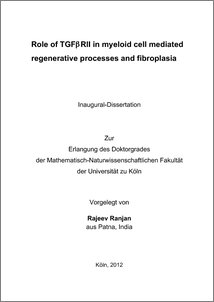Ranjan, Rajeev
(2012).
Role of TGFbRII in myeloid cell mediated regenerative processes and fibroplasia.
PhD thesis, Universität zu Köln.

![[img]](https://kups.ub.uni-koeln.de/style/images/fileicons/application_pdf.png)  Preview |
|
PDF
PhD_thesis_Rajeev_Ranjan.pdf
- Submitted Version
Download (25MB)
|
Abstract
Tissue repair and fibrosis are controlled by the interaction of different cell lineages, their
soluble factors and matrix signals. Recently, macrophages have been found to be crucial
for proper tissue repair. In particular, the role of Transforming growth factor-β1 (TGF-β1)
has been extensively studied during tissue repair and fibrosis. Fibrosis is characterized by
excessive production and deposition of extracellular matrix, as well as immune cell
infiltration. Macrophages are one of the main sources of TGF-β1. So far, studies on the
mechanisms of tissue repair and fibrosis have mainly focused on macrophages or TGF-β1
individually. However, the specific function of TGF-β1 on macrophages in tissue repair
and fibrosis still needs to be elucidated.
To understand the macrophage specific role of TGFβ1-TGFβRII signaling in tissue repair
and fibrosis, we generated a mouse model, which lacks TGFβRII in myeloid cells
(TGFβRIIfl/fl/LysMCre). We observed that during mechanical tissue injury TGFβRII
signaling in macrophages contributes to wound contraction, possibly by cross—talk
between macrophages and fibroblasts. The attenuated wound contraction was
accompanied by impaired myofibroblast differentiation and collagen deposition. However,
the loss of TGFβRII signaling in macrophages did not lead to reduced expression of TGF-
β1, which we proposed as one of the primary mechanisms in wound tissue underlying
reduced myofibroblast formation observed in TGFβRIIfl/fl/LysMCre mice.
Generation of cutaneous fibrosis by bleomycin injection for two and four weeks resulted in
reduced fibrosis in TGFβRIIfl/fl/LysMCre mice, compared to control mice. The mechanisms
leading to this phenotype were associated with reduced infiltration of immune cells,
reduced deposition of collagen and diminished production of inflammatory mediators such
as IL-1β, TNF-α and osteopontin-1 at the early stage of fibrosis formation. At the later
stage, the expression of inflammatory mediators in TGFβRIIfl/fl/LysMCre mice was not
altered compared to control mice, possibly due to compensatory mechanisms. Our data
leads to the hypothesis that the reduced fibrosis is caused by the reduced expression of
inflammatory mediators and accumulation of immune cells at the early stage of fibrosis in
TGFβRIIfl/fl/LysMCre mice.
Our results provide new insights into the crucial role of macrophage specific TGFβRII
signaling in tissue repair and fibrosis.
| Item Type: |
Thesis
(PhD thesis)
|
| Translated abstract: |
| Abstract | Language |
|---|
| Die Gewebereparatur, als auch die Fibrose sind durch die Interaktion unterschiedlicher
Zellen zueinander, löslicher Faktoren und über den Kontakt zur extrazellulären Matrix
reguliert. Makrophagen sind wichtige Regulatoren in der physiologischen und
pathologischen Wundheilung. TGF-β1 gilt als zentraler Wachstumsfaktor zur Regulation
epidermaler und mesenchymaler Reparaturprozesse. Die Entstehung von Fibrose ist
maßgeblich durch eine Fehlregulation der Homöostase der extrazellulären Matrix und der
Infiltration von Immunzellen charakterisiert, wobei Makrophagen eine entscheidende Rolle
zu spielen scheinen. Bisher ist über die Bedeutung von TGF-β1 auf die
Makrophagenfunktion in der Wundheilung wenig bekannt.
Um dieser Fragestellung nachzugehen, wurde ein Mausmodell generiert in dem TGFβRII
spezifisch in myeloiden Zellen deletiert wird (TGFβRII/LysMCre). Anhand dieses Modells
konnten wir zeigen, dass die TGFβRII vermittelte Signalkaskade in Makrophagen
maßgeblich zur Wundkontraktion beiträgt. Diese wird möglicherweise durch eine
parakrine Interaktion von Makrophagen und Fibroblasten vermittelt. Die veränderte
Wundkontraktion in TGFβRII/LysMCre Mäusen geht einher mit einer beeinträchtigten
Myofibroblastendifferenzierung und einer verminderten Kollagensynthese. Die Deletion
des TGF-β1 Rezeptors in Makrophagen führt nicht zu einer verminderten Expression von
TGF-β1 im Wundgewebe von TGFβRII/LysMCre Tieren, was möglicherweise den
beschriebenen Phänotypen hätte erklären können.
Die Bleomycin-induzierte Hautfibrose führt in TGFβRII/LysMCre Mäusen zu einer
signifikant verminderten Fibrosereaktion. Die Tiere weisen nach zweiwöchiger Injektion
ein verringertes Entzündungsfiltrat, eine verminderte Kollagenablagerung, als auch
deutlich weniger entzündliche Mediatoren einschließlich IL-1β, TNFα und Osteopontin auf.
Wird Bleomycin über einen längeren, vierwöchigen Zeitraum injiziert ist die
Entzündungsreaktion mit der der Kontrolltiere vergleichbar. Möglicherweise spielen dabei
kompensatorische Mechanismen eine Rolle.
Zusammenfassend liefert unsere Untersuchung einen Hinweis darauf, dass der TGFβ1
Signalweg in Makrophagen während der Wundheilung und in der Fibrosebildung
entzündungsstimulierend und profibrotisch wirkt. | German |
|
| Creators: |
| Creators | Email | ORCID | ORCID Put Code |
|---|
| Ranjan, Rajeev | rajeev.ranjan@uk-koeln.de | UNSPECIFIED | UNSPECIFIED |
|
| URN: |
urn:nbn:de:hbz:38-48304 |
| Date: |
9 May 2012 |
| Language: |
English |
| Faculty: |
Faculty of Mathematics and Natural Sciences |
| Divisions: |
Faculty of Mathematics and Natural Sciences > Department of Biology > Institut für Entwicklungsbiologie |
| Subjects: |
Natural sciences and mathematics |
| Uncontrolled Keywords: |
| Keywords | Language |
|---|
| TGFbeta | UNSPECIFIED | | Fibrosis | UNSPECIFIED | | Wound healing | UNSPECIFIED |
|
| Date of oral exam: |
20 June 2012 |
| Referee: |
| Name | Academic Title |
|---|
| Roth, Siegfried | Prof. Dr. | | Paulsson, Mats | Prof. Dr. |
|
| Refereed: |
Yes |
| URI: |
http://kups.ub.uni-koeln.de/id/eprint/4830 |
Downloads per month over past year
Export
Actions (login required)
 |
View Item |


